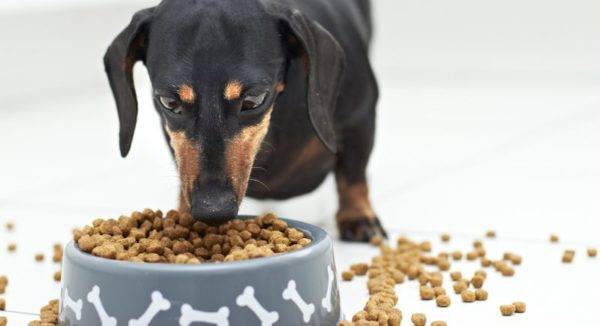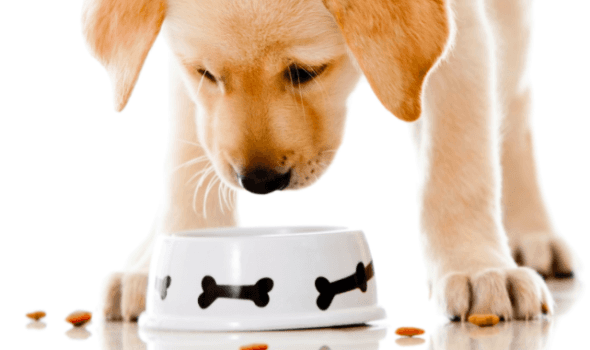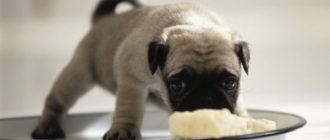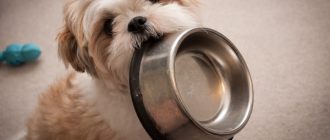Often the owners enthusiastically embarked on feeding their pet according to the principle – everything that is useful to me, useful to a friend my four-legged, face some problems since dogs often get sick when they get food from the owner’s table. There are other situations when the owner is tired of cooking large amounts of food for his once tiny but grown as big as a calf pet. Whatever the reason, the owners come to a single opinion and begin to select the most useful dry rations for your favorites. How to transfer a dog to dry food to change did not negatively affect the health of the ward?
Content
- 1. Rules for transferring a dog to dry food
- 2. Phased transfer of the dog to dry food
- 3. How to understand that the feed has come up
Rules for transferring a dog to dry food
Contents

Before radically changing the menu of your caudate (or tailless) comrade, it is worth familiarizing yourself with some postulates, underlying the dog’s conversion to dry food:
- It’s important not to rush. Any changes to the dog’s diet is stressful for her body on the replacement of natural products with industrial dry feed. If this is done sharply, then the animal often has different kind of health problems. As a result, the pet may suffer from defecation disorders – constipation or diarrhea, he may develop vomiting, increased gas formation and other disturbances in activity gastrointestinal tract. This is a good reason for gradual transfer of a dog to a new food for him.
- Better give preference to high feed quality class. Saving on dog food is a thing ungrateful. First, the stress of switching to “drying” in several times intensify. Secondly, having tasted granules with flavorings and amplifiers, the dog subsequently abandons better rations. Thirdly, choosing low-cost economical feeds, it should be noted that their consumption is much higher than that of feed top class. This is especially noticeable if the pet belongs to representatives of large or giant breeds. Ideally, before the shift diet, you need to consult a veterinarian who will offer the best option for your dog. If such there is no possibility, it’s worth to read the ratings of the best feed, choose from those that belong to the premium, super-premium and holistic most suitable. But, even following this recommendation, no one is safe from the fact that the feed is not suitable. Therefore worth prepare and choose some alternative rations on replacement.
- It is very important to maintain water balance. Getting natural food, the dog also gets some amount of moisture. But in the case of dry rations this will not happen. Now food and water for the pet are separate components. therefore it is worth making sure that the dog has round-the-clock access to clean drinking water. And if the dog often flips the bowl, you need to make sure that this does not happen with the water tank, and the pet was not left without the necessary drink. Especially the dog will torment thirst in the first days after switching to dry food, it will drink very often. This is normal and needs a pet satisfy. Another caveat – the dog begins to drink more, which means he will go to the toilet more often. Until the body is completely adapted to the new feeding regimen, it is worth walking more often his four-legged friend. This will not only save the house from evil smelling puddles, but also contribute to better absorption of food, as during movement, the digestive tract is more intense.
By the way, choosing the right menu based on age and size dogs, you should always feed him this food, without changing the brand, if there is no good reason for this.
Phased transfer of the dog to dry food
As already noted, when transferring dogs to ready-made rations to rush to anything. Moreover, it is necessary to do this when The pet has no health problems and feels great.
The entire transfer period can take from a week to one and a half. Should every day methodically increase the amount of dry food, and a portion Do less natural foods:
- The first two days, the ratio of natural products and dry the ration is 3: 1.
- 3, 4, 5 day – the amount of “drying” and “natural” balanced and is 50: 50%.
- The end of the first week – only 1/4 of all daily food received a pet, is previously familiar food, the rest is ready ration.
- 9, 10.11, 12th day – natural food is still on the menu dogs, but its share does not exceed 15% of the total diet. Further Dog can be fed exclusively prepared feeds.
It should be borne in mind that with this type of feeding, the break between feeding should be at least 12 hours, in extreme cases – 10 hours.
Read also:
- how much dry food to give the dog;
- dry food for dogs of small breeds;
- dry dog food for large breeds.
How to understand that the feed came up

This question is of interest to many beginner breeders or owners who have just decided to change the type of feeding their favorites. Naturally, the main indicator is health and the well-being of the pet. Among the warning signs, signaling that the feed is not suitable for him, the following can be noted phenomena:
- vomiting, difficulty stool or diarrhea;
- increased seasonal non-seasonal hair loss molting;
- redness of the ears;
- sour eyes;
- the dog became lethargic, lethargic, sleeping more than usual.
In this case, it is important to consult a veterinarian without thinking that this phenomenon will pass over time. Great, beautiful, woolly the cover is a “mirror” of the activity of the digestive tract. And if in this system If a malfunction occurs, the dog may have dandruff the appearance of itching, bald patches and other phenomena talking about negative changes.
Food allergies are a nuisance that many face. dog owners. And when transferring a pet from natural food to dry food it often manifests itself, so you should familiarize yourself with symptoms of allergic manifestations:
- itching of the skin and irritation (parasites are absent);
- foci of hair loss occur;
- weeping areas appear in the armpits;
- cloying, slightly sweet starts to come from the pet smell;
- lacrimation intensifies;
- darkish discharge from the ears appears.
This symptomatology requires the elimination of the pathogen of allergies and treatment that eliminates unpleasant symptoms. Naturally it is must be done under the supervision of a veterinarian.
If the dog calmly transferred the transition to a new diet, he the above symptoms are absent, he is cheerful and cheerful – that means selected food, this is what you need. But still the first time to the owner it’s worth looking at the quality of the pet’s chair, evaluating how often it’s goes to the toilet and if there are any changes in behavior.






